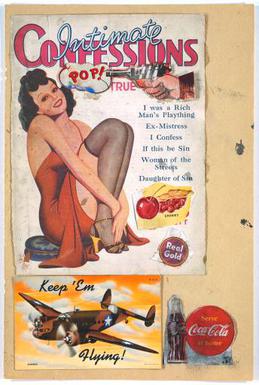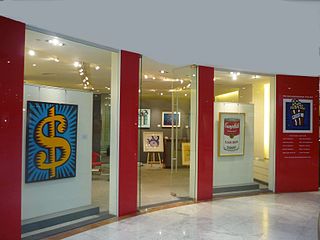Related Research Articles

Pop art is an art movement that emerged in the United Kingdom and the United States during the mid- to late-1950s. The movement presented a challenge to traditions of fine art by including imagery from popular and mass culture, such as advertising, comic books and mundane mass-produced objects. One of its aims is to use images of popular culture in art, emphasizing the banal or kitschy elements of any culture, most often through the use of irony. It is also associated with the artists' use of mechanical means of reproduction or rendering techniques. In pop art, material is sometimes visually removed from its known context, isolated, or combined with unrelated material.

Yayoi Kusama is a Japanese contemporary artist who works primarily in sculpture and installation, and is also active in painting, performance, video art, fashion, poetry, fiction, and other arts. Her work is based in conceptual art and shows some attributes of feminism, minimalism, surrealism, Art Brut, pop art, and abstract expressionism, and is infused with autobiographical, psychological, and sexual content. She has been acknowledged as one of the most important living artists to come out of Japan, the world's top-selling female artist, and the world's most successful living artist. Her work influenced that of her contemporaries, including Andy Warhol and Claes Oldenburg.

The Gagosian Gallery is a contemporary art gallery owned and directed by Larry Gagosian. The gallery exhibits some of the most influential artists of the 20th and 21st centuries. There are 16 gallery spaces – five in New York City, three in London, two in Paris, and one each in Basel, Beverly Hills, Rome, Athens, Geneva and Hong Kong.
David Moos is the president of David Moos Art Advisory and a co-founder of The Museum Exchange.
Dan Christensen, was an American abstract painter He is best known for paintings that relate to Lyrical Abstraction, Color field painting, and Abstract expressionism.

Soft sculpture is a type of sculpture or three dimensional form that incorporates materials such as cloth, fur, foam rubber, plastic, paper, fibre or similar supple and nonrigid materials. Soft sculptures can be stuffed, sewn, draped, stapled, glued, hung, draped or woven. These materials and techniques distinguish soft sculptures from more traditional hard sculptures made from, for example, stone, bronze or wood that are then carved or modelled.
The 10th Street galleries was a collective term for the co-operative galleries that operated mainly in the East Village on the east side of Manhattan, in New York City in the 1950s and 1960s. The galleries were artist run and generally operated on very low budgets, often without any staff. Some artists became members of more than one gallery. The 10th Street galleries were an avant-garde alternative to the Madison Avenue and 57th Street galleries that were both conservative and highly selective.
NO!art is a radical avant-garde anti-art movement started in New York in 1959. Its founders sought to deliver a shock to the complacent consumerist society around them.
Judith E. Stein is a Philadelphia-based art historian and curator, whose academic career has focused on the postwar New York art world. She has written a biography of the art dealer Richard Bellamy, as well as feature articles regarding artists including Jo Baer, Red Grooms, Lester Johnson, Alfred Leslie and Jay Milder.
David Whitney was an American art curator, collector, gallerist and critic. He led a very private life and was not well known outside the art world, even though he participated naked in the 1965 Claes Oldenburg happening Washes. He was the life partner of architect Philip Johnson (1906–2005) for 45 years until their deaths five months apart. He was also a close friend of Andy Warhol.

Pop and Contemporary Fine Art is a contemporary art gallery located at Orchard Road, Central Region, Singapore. Residing on the third floor of Palais Renaissance, the gallery specializes in original paintings, limited edition lithographs, screen prints, etchings and sculptures from the Pop and Contemporary Art genres.
Ivan C. Karp was an American art dealer, gallerist and author instrumental in the emergence of pop art and the development of Manhattan's SoHo gallery district in the 1960s.
Erik La Prade is an American freelance journalist, poet, photographer, and non-fiction writer. La Prade has had 14 publications. He is based in New York City.
James Bumgardner (1935–2015) was an expressionist/figurative painter, multi-media artist, and stage set designer who was a Virginia Commonwealth University professor of art in the VCU School of the Arts. As an undergraduate student at Richmond Professional Institute (RPI), Bumgardner was encouraged by his mentor Jewett Campbell to study with the notable Art Students League of New York instructor Hans Hoffman (1880–1966), and Bumgardner received the last scholarship given by Hoffman, a German-born American abstract expressionist painter. Using his scholarship, Bumgardner studied with Hoffman in Provincetown in 1957, during which time he became friends with gallery director Richard Bellamy and artist Jan Müller. In 1963 in Richmond Jim Bumgardner and Jon Bowie co-directed a series of multi-media events or "happenings". The first was called "Synthesis" and was influenced by the productions of Allan Kaprow and the ONCE Festival of New Music of Ann Arbor, Michigan. After "Synthesis" Bumgardner and Jon Bowie invited notable outside performance and visual artists who joined in a series of annual "Bang, Bang, Bang Arts Festival" happenings in Richmond.
Robert Scull was an American art collector, best known for his "world-famous collection of Pop and Minimal art". Born in New York to Russian immigrant parents, Scull dropped out of high school and had various jobs until his wife inherited a share of a taxi business. When this thrived, the couple started buying abstract art and later pop art.
Richard Hu Bellamy, was an American art dealer, known as Dick Bellamy.
Jean Follett was an American painter and one of the innovators of assemblage art in the United States. She was a member of the New York abstract art movement of the 1940s and 1950s.

Richard Nonas was an American anthropologist and post-minimalist sculptor. He lived and worked in New York City.
Judith Goldman is a writer, curator and publisher who lives in New York City.

Kusama: Infinity is a 2018 American biographical documentary film that chronicles the life and art of Japanese contemporary artist Yayoi Kusama, now one of the best-selling artists in the world, who overcame sexism, racism, and a stigma of mental illness to achieve international recognition relatively late in her career. Magnolia Pictures released the film on September 7, 2018.
References
- ↑ Glueck, Grace (January 3, 1986). "Robert Scull, Prominent Collector of Pop Art". The New York Times.
- 1 2 3 4 5 Stein, Judith E. (2016). Eye of the Sixties: Richard Bellamy and the Transformation of Modern Art. Farrar, Straus and Giroux. ISBN 9780374715205.
- ↑ Tomkins, Calvin (May 26, 1980). "A Good Eye and a Good Ear". The New Yorker.
- ↑ Berman, Judy (July 28, 2016). "Review/Eye of the Sixties by Judith Stein". The Guardian. Retrieved October 30, 2017.
- ↑ Smith, Roberta (April 3, 1998). "Richard Bellamy, Art Dealer, Is Dead at 70". The New York Times.
- ↑ La Prade Eric. Breaking Through Richard Bellamy and the Green Gallery 1960–1965 Twenty-Three Interviews, pp. 202–205, Midmarch Arts Press, 2009 ISBN 978-1877675782